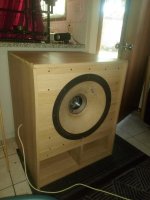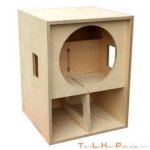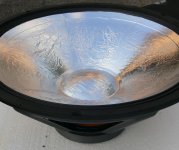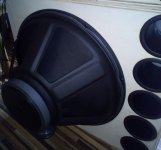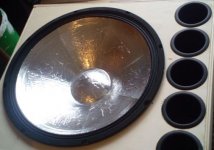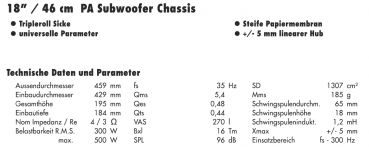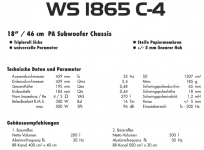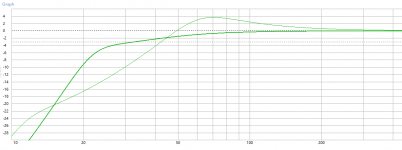IMG_20210108_171719.jpg - Google Drive
hey guys its a google drive link but i basicly had this unknown 18inch driver that needed a repair ti the tinsil leads and finaly did a box for it the box was aimed at 13 cubic feet to be tuned at 35hz it sounds alot diferent to my other ported boxes as this one has an internal l port and doesnt seem to a wide a bass frequency as my others but its running at 90hx off a electronic crossover and have a good 600watt to feed it
but need to move things around a bit because halfway its makeing my cd in my luxman cd player jump
hey guys its a google drive link but i basicly had this unknown 18inch driver that needed a repair ti the tinsil leads and finaly did a box for it the box was aimed at 13 cubic feet to be tuned at 35hz it sounds alot diferent to my other ported boxes as this one has an internal l port and doesnt seem to a wide a bass frequency as my others but its running at 90hx off a electronic crossover and have a good 600watt to feed it
but need to move things around a bit because halfway its makeing my cd in my luxman cd player jump
Shame not see it 🙂
[
2013-10-13 19.29.52.jpg - Google Drive
IMG_20140627_141253.jpg - Google Drive
i no longer have these but the 15's were jbl 2205a
the commercial bin was jbl 2241 i had also tried a 2245 in same box that was cleaner bass
but this bandpass 18in that i just built with the l port does not seem to have such a wide frequency and is now where near as warm sounding as the others but it certainly has alot more bottom end but extremely clean and flat
is that common with this style box???
as i did notice jbl make a similer desing and somtimes run a hornloaded 15in on to
im only playing it in my small lounge but sound like the new box needs a hall or a room 50mt x 50mt min to roll out that 50hz wallow
IMG_20210108_172238.jpg - Google Drive
but im kind of craving that warmth the higher tuned woofers were giving
i have one more box to build for a 15i as i bought both drivers together looks like a jbld130 or similer i might tune this box to 80-150hz
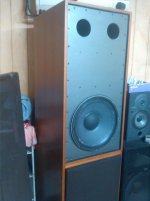
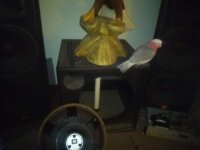
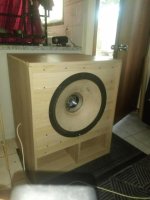
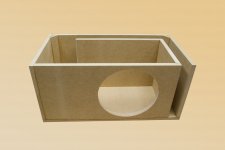 this is what i built here tuned at 35hz it came to 13cubic feet volume without bracing i used a band pass box desing calculator
this is what i built here tuned at 35hz it came to 13cubic feet volume without bracing i used a band pass box desing calculator An externally hosted image should be here but it was not working when we last tested it.
Last edited:
o.k. I will show my 18 inch bass project
Hello,
ok I will show my 18 inch project.
I admit I exaggerated a little bit. I have put four 18 inch woofers - Mivoc WS-1865 C4 per side in a Linkwitz - alike impulse compensation with one driver turned around and turned in phase in order to minimize K2/K4 distortion.
The bass driver:
Subwoofer Mivoc WS 1865 C-4 specifications.
All bass drivers got an aluminium covering of the diaphragm on one side. It is an aluminium foil 3 times thicker than usual aluminium used in the household for food. The bass driver got 30 grams more of diaphragm weight due to this treatment.
The box is made from 12mm birch plywood and 1cm concrete / cement on the inside.
Reflex is tuned to 25 Hertz and the complete box is completely flat from 20 Hertz to 80 Hertz (using dsp).
On top of the box is a fullrange 10 inch driver with aluminium foil on both sides (sandwich), completely flat from 80 Hertz to 18 khz. The tweeters are not active it is a 10 inch fullrange driver. Crossover is integrated in a Behringer Inuke NU3000dsp and has 48db Linkwitz filter slopes.
A simulation of maximum output power shows for eight 18 inch drivers with linear cone travel of +-5mm nearly 130 decibels at 35 Hertz.
One driver has 1320cm2 (eight drivers=10560cm2), 41cm diaphragm opening.
While listening loud music I didn't get the drivers to move more than +- 1mm before it got too loud for me. I capitulated.
Hello,
ok I will show my 18 inch project.
I admit I exaggerated a little bit. I have put four 18 inch woofers - Mivoc WS-1865 C4 per side in a Linkwitz - alike impulse compensation with one driver turned around and turned in phase in order to minimize K2/K4 distortion.
The bass driver:
Subwoofer Mivoc WS 1865 C-4 specifications.
All bass drivers got an aluminium covering of the diaphragm on one side. It is an aluminium foil 3 times thicker than usual aluminium used in the household for food. The bass driver got 30 grams more of diaphragm weight due to this treatment.
The box is made from 12mm birch plywood and 1cm concrete / cement on the inside.
Reflex is tuned to 25 Hertz and the complete box is completely flat from 20 Hertz to 80 Hertz (using dsp).
On top of the box is a fullrange 10 inch driver with aluminium foil on both sides (sandwich), completely flat from 80 Hertz to 18 khz. The tweeters are not active it is a 10 inch fullrange driver. Crossover is integrated in a Behringer Inuke NU3000dsp and has 48db Linkwitz filter slopes.
A simulation of maximum output power shows for eight 18 inch drivers with linear cone travel of +-5mm nearly 130 decibels at 35 Hertz.
One driver has 1320cm2 (eight drivers=10560cm2), 41cm diaphragm opening.
While listening loud music I didn't get the drivers to move more than +- 1mm before it got too loud for me. I capitulated.
Attachments
-
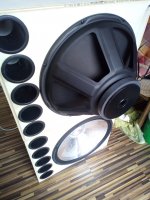 IMG_20210505_114954.jpg447.8 KB · Views: 283
IMG_20210505_114954.jpg447.8 KB · Views: 283 -
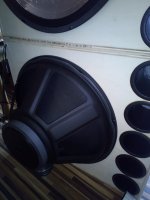 IMG_20210505_114936.jpg362.8 KB · Views: 281
IMG_20210505_114936.jpg362.8 KB · Views: 281 -
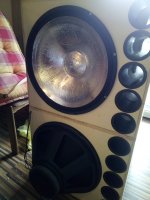 IMG_20210505_114928.jpg414.4 KB · Views: 277
IMG_20210505_114928.jpg414.4 KB · Views: 277 -
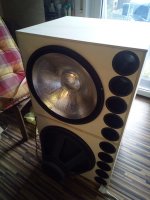 IMG_20210505_114920.jpg407.4 KB · Views: 263
IMG_20210505_114920.jpg407.4 KB · Views: 263 -
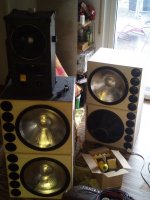 IMG_20210505_114858.jpg428.1 KB · Views: 281
IMG_20210505_114858.jpg428.1 KB · Views: 281 -
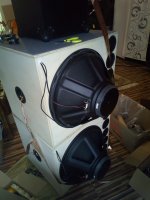 IMG_20210504_185541.jpg405.1 KB · Views: 496
IMG_20210504_185541.jpg405.1 KB · Views: 496 -
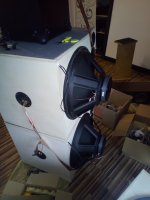 IMG_20210504_185530.jpg385.2 KB · Views: 503
IMG_20210504_185530.jpg385.2 KB · Views: 503 -
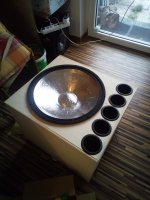 IMG_20210504_185518.jpg419 KB · Views: 515
IMG_20210504_185518.jpg419 KB · Views: 515 -
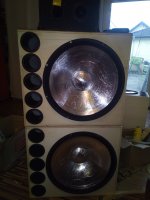 IMG_20210504_185506.jpg396.7 KB · Views: 516
IMG_20210504_185506.jpg396.7 KB · Views: 516 -
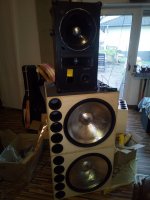 IMG_20210504_185454.jpg403.1 KB · Views: 530
IMG_20210504_185454.jpg403.1 KB · Views: 530
Last edited:
We have 3 different thicknesses of foil for food here. Commercial (very thin), household and barbecue (thickest).All bass drivers got an aluminium covering of the diaphragm on one side. It is an aluminium foil 3 times thicker than usual aluminium used in the household for food.
I wish I was closer to you. I might have been able to get that foil a little smoother for you. It takes a good deal of practice and patience. I have dealt with aluminum, polyester and polypropylene foils in the past.
Hello Cal Weldon,
I used thick aluminium foil which is used for locking the steam in sauna constructions. I measured the weight of this foil, it is three times heavier (and for this thicker) than the thin commercial quality.
I used thick aluminium foil which is used for locking the steam in sauna constructions. I measured the weight of this foil, it is three times heavier (and for this thicker) than the thin commercial quality.
I use aluminium because of D.A. Barlows information:
D.A. Barlow: The Development of a Sandwich-Construction Loudspeaker System. Page 159-171. From the AES anthology of articles on loudspeakers, article written 1970.
Citation begin (page 160):
"As paper cones are thin, these resonances are bending modes. The stiffness of a material in bending, for any given geometry and edge condition, is proportional to Young`s modulus and the cube of the thickness, ignoring variations in Poisson`s ratio. ... On this basis, paper is much stiffer than metals (except beryllium) in spite of its much lower modulus, and lower density materials such as expanded plastics are even stiffer, as may be seen in Table. A method of obtaining still greater stiffness is sandwich construction. ... In bending, the maximum stress and strain occur at the outer fibers, the material at the neutral axis being unstressed. Better use of material can thus be made by concentrating it at the outer fibers. A familiar example is the tube. In the case of large areas, the same effect is obtained by using a thin high-modulus material for the outer surfaces, and a light-weight material or form of construction for the core. ... This sandwich will of course be much stiffer than the same total weight of either material used separately. The skin material should have the maximum ratio of modulus/density. Beryllium, the best material, is impractical due to difficulty of rolling and possible toxicity, so aluminium is the obvious choice. The core should be as stiff as possible in the thickness direction and have minimum density. Honeycomb aluminium or impregnated paper are frequently used in aircraft construction and could be used for flat diaphragms."
Citation end.
D.A. Barlow: The Development of a Sandwich-Construction Loudspeaker System. Page 159-171. From the AES anthology of articles on loudspeakers, article written 1970.
Citation begin (page 160):
"As paper cones are thin, these resonances are bending modes. The stiffness of a material in bending, for any given geometry and edge condition, is proportional to Young`s modulus and the cube of the thickness, ignoring variations in Poisson`s ratio. ... On this basis, paper is much stiffer than metals (except beryllium) in spite of its much lower modulus, and lower density materials such as expanded plastics are even stiffer, as may be seen in Table. A method of obtaining still greater stiffness is sandwich construction. ... In bending, the maximum stress and strain occur at the outer fibers, the material at the neutral axis being unstressed. Better use of material can thus be made by concentrating it at the outer fibers. A familiar example is the tube. In the case of large areas, the same effect is obtained by using a thin high-modulus material for the outer surfaces, and a light-weight material or form of construction for the core. ... This sandwich will of course be much stiffer than the same total weight of either material used separately. The skin material should have the maximum ratio of modulus/density. Beryllium, the best material, is impractical due to difficulty of rolling and possible toxicity, so aluminium is the obvious choice. The core should be as stiff as possible in the thickness direction and have minimum density. Honeycomb aluminium or impregnated paper are frequently used in aircraft construction and could be used for flat diaphragms."
Citation end.
Yes, the vapour retarder type foil, at about 0.1 mm it is very thick. Hard to work with I am guessing. Was it the self adhesive type? That can also make it harder for you.
Last edited:
Hello Cal W,
it is not self adhesive. I use normal glue.
The big 18'' diaphragm gets 30 gramms more weight and I have a loss of approx. 1 decibel. (Diaphragm has 185gramms moving mass).
The Thiele Small parameters play no role for me in loudspeaker design as I always use digital dsp and measurement equipment to get the speaker work with flat frequency response. The loudspeaker with the electronical filter form together a new transfer function with ideal properties. In the end impulse reproduction is good. And I am happy - it sounds good.
I had some worry about using bass reflex. But in the listening test, I can not hear any loss in detail due to the resonant reflex opening.
it is not self adhesive. I use normal glue.
The big 18'' diaphragm gets 30 gramms more weight and I have a loss of approx. 1 decibel. (Diaphragm has 185gramms moving mass).
The Thiele Small parameters play no role for me in loudspeaker design as I always use digital dsp and measurement equipment to get the speaker work with flat frequency response. The loudspeaker with the electronical filter form together a new transfer function with ideal properties. In the end impulse reproduction is good. And I am happy - it sounds good.
I had some worry about using bass reflex. But in the listening test, I can not hear any loss in detail due to the resonant reflex opening.
The Mivoc 18 inch driver "Mivoc WS 1865 C4" has - due to the PDF information 96 decibel efficiency.
With the added mass of aluminium foil the driver loses approximately 1db of efficiency. (Moving mass is 185 gramms - added mass is 30 gramms).
By using eight 18 inch drivers the summed efficiency is high:
95 db with 1 driver
98 db with 2 drivers
101 db with 4 drivers
104 db with 8 drivers
Even if I assume the driver has 3 db less than described in the specification still 101db efficiency is a nice thing.
While listening music it is impossible to get any excursion beyond +-1.5mm, my ears cannot stand this loudness. And chuffing of the reflex ports at this level is not occuring at all - even while listening to sub bass music.
I use a Behringer Inuke NU3000dsp amplifier with a subsonic filter at 20Hertz. The power LEDs are hardly working so here you can physically see that the efficiency is high.
With the added mass of aluminium foil the driver loses approximately 1db of efficiency. (Moving mass is 185 gramms - added mass is 30 gramms).
By using eight 18 inch drivers the summed efficiency is high:
95 db with 1 driver
98 db with 2 drivers
101 db with 4 drivers
104 db with 8 drivers
Even if I assume the driver has 3 db less than described in the specification still 101db efficiency is a nice thing.
While listening music it is impossible to get any excursion beyond +-1.5mm, my ears cannot stand this loudness. And chuffing of the reflex ports at this level is not occuring at all - even while listening to sub bass music.
I use a Behringer Inuke NU3000dsp amplifier with a subsonic filter at 20Hertz. The power LEDs are hardly working so here you can physically see that the efficiency is high.
Attachments
Last edited:
Simulation of WS 1865 C4 in WinISD
What does happen if you put a driver into an enclosure which is too small – ignoring Thiele Small parameters?
While simulating the 18 inch Mivoc driver in an eclosure of 150 Liters (for 2 drivers) and 800 liters - with reflex in both boxes tuned to 25 Hertz, this is the graph before applying dsp linearization of the frequency response:
You get more efficiency in the frequency region between 45 and 150 Hertz. You get + 4 to 5db.
You lose efficiency in the region between 25 and 45 Hertz. You lose 8 db at 25 Hertz, 6db at 30 Hertz.
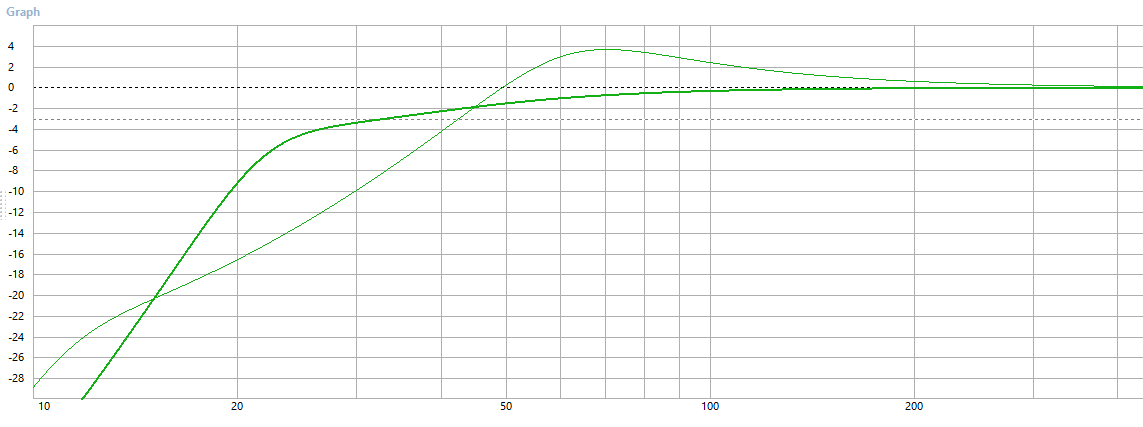
If you take into consideration that the region between 45 and 150 Hertz is the bass region used most in music statistically than a loss of efficiency between 25 and 45 Hertz is not an electrical problem for the most real life setups:
As long as you do not listen to music with extreme deep bass for longer time there should be no heating problem with putting a driver in a smaller enclosure and correcting the amplitude with dsp control of frequency response.
The Mivoc driver has in this enclosure - which is too small - 150 Liters vs 800 Liters – for two drivers in one box an effiency of not only 104 db at 70 Hertz in a big enclosure – but a plus of 4-5 db at this frequency, it gets 108 db efficiency!
What does happen if you put a driver into an enclosure which is too small – ignoring Thiele Small parameters?
While simulating the 18 inch Mivoc driver in an eclosure of 150 Liters (for 2 drivers) and 800 liters - with reflex in both boxes tuned to 25 Hertz, this is the graph before applying dsp linearization of the frequency response:
You get more efficiency in the frequency region between 45 and 150 Hertz. You get + 4 to 5db.
You lose efficiency in the region between 25 and 45 Hertz. You lose 8 db at 25 Hertz, 6db at 30 Hertz.
If you take into consideration that the region between 45 and 150 Hertz is the bass region used most in music statistically than a loss of efficiency between 25 and 45 Hertz is not an electrical problem for the most real life setups:
As long as you do not listen to music with extreme deep bass for longer time there should be no heating problem with putting a driver in a smaller enclosure and correcting the amplitude with dsp control of frequency response.
I think you even have an efficiency benefit with a driver getting less heat in normal use!
The Mivoc driver has in this enclosure - which is too small - 150 Liters vs 800 Liters – for two drivers in one box an effiency of not only 104 db at 70 Hertz in a big enclosure – but a plus of 4-5 db at this frequency, it gets 108 db efficiency!
Attachments
- Home
- Loudspeakers
- Subwoofers
- Just wanted to show off my new 18in build
